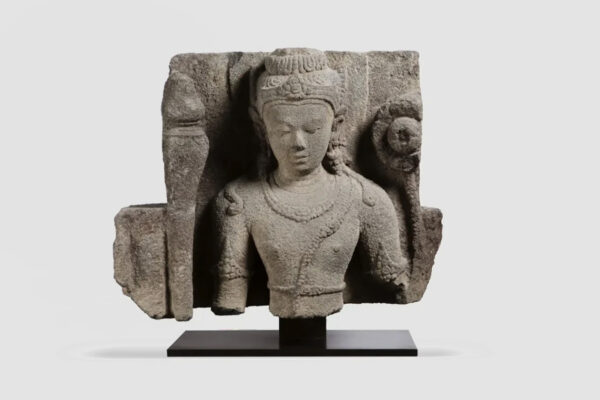Ivory estimate
Do you own an Asian ivory object and want to know its value? Whether you’re a passionate collector or have a family heirloom, having your ivory appraised is an essential step in understanding its true potential. Our Asian art experts will provide you with a free, confidential estimate within 48 hours, and will guide you through the entire process, whether you wish to sell at auction or simply find out the value of your piece.
Estimates and prices for Asian ivory
Ivory regulations
Asian ivories are subject to CITES (Convention on International Trade in Endangered Species of Wild Fauna and Flora), which strictly regulates the ivory trade to protect endangered species, notably elephants. At auction, ivory objects must comply with CITES regulations, which impose restrictions on the import, export and even sale of these materials. For several decades now, antique ivories, often associated with Asian or European art, have been allowed to be offered for sale only if their provenance proves that they date from before 1947, a date set to differentiate antique ivories from prohibited later products. What’s more, some jurisdictions, such as the United States, strictly prohibit all imports of ivory, regardless of age, while the European Union imposes a rigorous authorization framework for exports.
Asian ivory price chart
| Object typology | Low estimate (€) | Average estimate (€) | High estimate (€) |
|---|---|---|---|
| Ivory Imperial Seal | 100,000 | 150,000 | 500,000 |
| Buddha statues in Ivory | 10,000 | 50,000 | 250,000 |
| Animal Okimono | 5,000 | 15,000 | 60,000 |
| Netsuke in Ivory | 3,000 | 10,000 | 30,000 |
| Stamp and Sculpture Boxes | 5,000 | 15,000 | 50,000 |
| Carved Canton balls | 1,000 | 10,000 | 70,000 |
| Sculpted Plaques and Panels | 5,000 | 15,000 | 250,000 |
This table shows estimate ranges for the main categories of Asian ivory objects, based on auction results.
Why should I have my Asian ivory object appraised?
If you own an Asian ivory object and would like to know its value, you have several options for obtaining a reliable estimate:
Getting an accurate estimate of your ivory has several advantages:
For auction: If you’re planning to sell your ivory, knowing its current value helps you set a fair and attractive price.
For insurance: In the event of a claim or damage, an estimate enables you to insure your room properly.
As part of an inheritance: If you have inherited an ivory object, you may need an appraisal for inheritance tax purposes or to divide the inheritance fairly.
Curiosity: You may simply want to know the value of your ivory, especially if it’s an heirloom or family heirloom.

How do you get your ivory appraised with Asium?
Nothing could be simpler! You can request an estimate directly online via our form. Simply upload photos of your ivory object and add a description. Our experts will get back to you within 48 hours with a confidential estimate.
For larger collections or high-value objects, we also offer in-home appraisal services or the possibility of attending our appraisal days, where you can bring your ivory for an in-person appraisal.
How to recognize an Asian ivory object?
It can be difficult to recognize genuine Asian ivory, but here are a few criteria to consider:
- Basic color: Natural ivory has a creamy or off-white color when new. Over time, it takes on a patina that can vary from pale yellow to amber brown, often indicating its age.
- Age cracks: Over time, ivory can develop small cracks called “age cracks”. They usually appear on the surface and follow fine, irregular patterns, often visible under a magnifying glass.
- Carved details: Asian ivory carvings are often charged with symbolism and deep cultural significance. These meticulous details are essential to understanding and valuing these objects.
- Signatures and stamps : The presence of artists’ signatures or imperial stamps adds value to Asian ivories, as they attest to their authenticity and reinforce their cultural and historical value.
- Carving techniques: The technique used to make ivory varies according to period and place of origin, and has a direct influence on its value. In China, imperial pieces are distinguished by their often imposing carvings and intricate engravings. Moreover, Japanese sculptors are renowned for their meticulous workmanship, particularly in netsuke, small, detailed carvings used as clasps for kimonos. Mughal ivories are characterized by openwork motifs and sophisticated reliefs.
How do you assess the value of your ivory?
When you hold your Asian coral, there are several criteria that can help you determine its value. Here’s a detailed guide to help you value your item accurately:
Origin and production period
The geographical origin and period of production of an ivory are key elements in its appraisal. Ivories from regions such as China (Ming or Qing dynasties), Japan (Edo period), or India (18th-19th centuries) are particularly prized for their quality and history. The older the object, the higher its value tends to be, especially if it can be precisely dated thanks to a documented provenance.
Craftsman’s signature
The presence of a craftsman’s signature often enhances the value of an ivory, particularly if it is discreetly engraved on the underside of the object or on its base. The signatures of famous craftsmen, such as those of Masanao for netsuke or of craftsmen from the Qing imperial workshops, provide a guarantee of authenticity and can significantly increase the estimate.
Provenance and ownership history
Ivory with a documented provenance, for example from a prestigious collection or sold at auction, is generally valued more highly. A clear provenance reinforces the object’s authenticity and enables its history to be traced, adding value, especially for rare pieces.

A brief history of Asian ivory
Ivory has a long history in Asia, dating back several millennia. Used for its smooth texture and ease of carving, ivory is highly prized in Asian cultures for artistic and religious creations. As far back as ancient times, notably in China and India, craftsmen carved ivory objects for religious rites, personal adornment and prestigious gifts. The exceptional quality of ivory enabled extremely fine detail, particularly in the depiction of divinities, symbolic animals and scenes of daily life. In India, ivory was integrated into the traditions of Buddhist and Hindu art, while in China, it found its place in temple decorations and objects of worship.
Under the Chinese Ming and Qing dynasties, ivory art reached an exceptional level of refinement. Chinese craftsmen developed increasingly sophisticated techniques, and ivory became a prized medium for prestige objects, such as seals, boxes, fans and religious statuettes. Intricate carvings, such as the Canton concentric balls, also emerged, illustrating the remarkable talent of the artists of the time. In Japan, ivory was used for netsuke, small utilitarian and decorative objects attached to the belts of kimonos, often engraved with mythological scenes or animals.
The Asian ivory trade flourished until modern times, fuelled by strong domestic and international demand. However, in the face of over-exploitation and the threat of elephant extinction, international regulations, such as CITES, were introduced to limit this trade. Today, antique ivory is highly regulated in the art market, and collectors prefer historical pieces with proof of origin and age. This legal framework aims to protect the species while preserving and passing on the heritage of ivory craftsmanship, an art that is an integral part of Asian history.
Our experts in ivory
-

TaHsi CHANG
Specialist in the arts of VIETNAM and CHINA
-

Eunbi HA
Our areas of expertise
Your questions, our answers
What are the main criteria for assessing the value of an Asian ivory object?
You’ll need to look at rarity, quality of the sculpture, provenance, state of preservation and the artist’s signature.
Are Asian ivory objects authorized for sale?
Regulations vary, but objects manufactured before 1947 can generally be sold in the EU with a CITES permit.
Previously appraised by Asium
The Asium estimation service is...

Simple
and free
A few photos of your work, a few words of description and you're all set !

Fast
but not too fast
Our experts are serious, they take the time to research and get back to you within a week.

Reliable
and confidential
Our auctioneers are the Sherlock Holmes of the art market.































